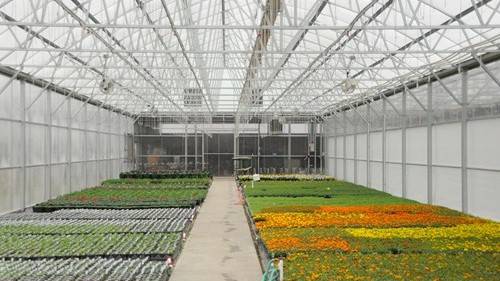Controlled release fertilizers are commonly used in the nursery industry for fertilizing trees and shrubs. Many growers also use them for mums, perennials and other outdoor grown crops, but are not commonly used in the greenhouse since water soluble fertilizers are easy to apply and application rates can be altered depending on the crop requirements, weather and plant size. Now there is movement towards using controlled release fertilizers with greenhouse crops.
What is a controlled release fertilizer?
Controlled release fertilizer consists of water soluble fertilizer that is encased within a polymer coating, forming a round prill. The polymer coating has small holes in which water passes into the prill, solublizes the fertilizer and then the fertilizer slowly leaches from the prill. Controlled release fertilizers have different N-P-K analyses and may or may not include micronutrients. They also have different length of releases, expressed as months, days or “Type”, which determine how long the controlled release fertilizer will persist at an average temperature of 70-77˚F (21-25˚C), depending on the manufacturer.
What determines the longevity of release?
The longevity of the release of a controlled release fertilizer depends on the thickness of the polymer coating surrounding the prill. For example, a controlled release fertilizer with a 3-4 month release can be extended to 8-9 months simply by increasing the thickness of the polymer coating. Note that as the longevity of the release increases, the required application rate also increases. For example, a 3-4 month release fertilizer may have an application rate of 6 lbs/cu yd, but the same fertilizer with a release time of 8-9 has an application rate of 9 lbs/cu yd. So if a grower requests a custom blend made with 6 lbs/cu yd of a 13-13-13 controlled release, the first question to ask is what is the length of release?
What influences the fertilizer release?
Moisture is needed to begin the release of controlled release fertilizer. If the growing medium dries out, it can greatly reduce the amount of fertilizer released. Beyond this, temperature has the greatest influence on release. Controlled release fertilizer works well at normal growing temperatures for a crop, but if temperature is below 50˚F (10˚C) there is almost no fertilizer release and if it is above 90˚F (32˚C), release can be excessive. Below is a chart that shows the relationship between temperature and the length of release of a product rated for 6 months:
| Temperature Effect on release Rate |
| Average Soil Temp |
60 °F |
70 °F |
80 °F |
90 °F |
| Longevity |
7-8 months |
6 months |
4 months |
3 months |
How is it applied?
Controlled release fertilizer is applied either as a top-dress or pre-incorporated into the growing medium prior to planting. If it is top-dressed, the controlled release fertilizer is placed on top of the growing medium surface after planting. The disadvantage of this type of application, is the prills can fall out of the container when it is disturbed. Also if water is applied faster than it soaks into the growing medium, the prills float and can flow out over the pot rim.
The second application method is mixing the controlled release fertilizer directly into the growing medium, or pre-incorporation. The application rate is expressed as pounds per cubic yard (lbs/cu yd) and varies from 3-15 lbs/cu yd. For greenhouse crops, the rate should be 3-6 lbs/ cu yd. The advantage of pre-incorporating a controlled release fertilizer is the ease for a grower and the prills remain in the growing medium. The unused product must be used within one month after manufacturing to avoid excessive fertilizer salt build up in the unused growing medium.
